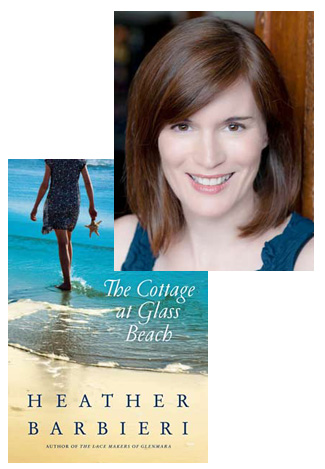Heather Barbieri & The Novel as Remembrance

All novels are personal, of course, but The Cottage at Glass Beach holds a particularly special meaning for Heather Barbieri. Although the storyline, about a woman trying to resolve a mystery from her family’s past while she’s still reeling from a blow to her marriage, has little to do with Barbieri’s own experience, the novel’s themes of motherhood resonated deeply with her during the writing process, as she explains in this guest essay…
I’d just submitted an outline and sample chapters for The Cottage at Glass Beach to my agent when the news came. My previously healthy, active mother, the woman who was frequently asked what products she used to keep her appearance so young (answer: the old school version of Oil of Olay), had been flown to the emergency room here in Seattle. It took a day or two before the doctors realized she had one of the worst conditions possible, cerebral amyloidosis, from which there was no recovery. (C. a. is a little known member of the Alzheimer’s family of illnesses; there’s no treatment, no cure.) She never regained consciousness and died within a few days—better for her, given the prognosis; hard for us, as it is for so many who find themselves suddenly bereft.
Two weeks later, I had a book deal, but was struggling to get my bearings. As had been happening frequently since my mother’s death, a blue jay perched in the rhododendron bush across from my office window, trilling in what might have been interpreted as encouragement and staring me in the eye. It’s going to be all right, it seemed to say. Whenever I was feeling uncertain it, or one of its brethren, would appear to cheer me up at just the right time. (One of the birds had alighted on the dining room windowsill when we were telling my dad that Mom had passed away, tapping on the glass to get our attention.) Blue had been her favorite color, and the birds became her emissaries, signs and wonders, in a time of need.
17 June 2012 | guest authors |
How DID That Kickstarter Campaign Work?
Since running a successful Kickstarter campaign to develop a new iteration of Beatrice, I’ve been noticing more and more people talking about what makes these things work—posts in the “9 essential tips” or “5 Kickstarter champs share their secrets” vein. Some of the advice resonates with me more than other bits; for example, I would agree that the pre-planning stage was absolutely crucial. Because I took the time to think through my project in great detail, I was able to tell people exactly what I wanted to do with the money they were contributing, not just threaten to make something cool, and I “knew” exactly how much I’d need to ask for to make it happen.
Conventional wisdom, to the extent that you can have conventional wisdom about a service that’s only been in existence for four years, says that you really ought to create a video for your Kickstarter pitch—that it’s a direct, engaging way of telling your story to potential backers. But I wouldn’t call it a universal necessity. I gave it a whirl, stuck my Flip on its tripod, pointed it at my nice chair, then sat down and talked about my goals. I couldn’t quite get as comfortable as I wanted to with it, though, so I ended up scrapping all the footage and just going with a text-and-pictures presentation.
(Part of the problem, in retrospect, was that “a guy sitting in a chair telling you about his Kickstarter project” just isn’t my idea of dynamic filmmaking. If I ever do another Kickstarter, I’ll have to see if I can come up with a more lively scenario for a video pitch—something like Neal Stephenson’s CLANG promo or Peter Riegert’s concept reel for his documentary about Prospect Cemetery.)
So what did work for me?
13 June 2012 | theory |

 Our Endless and Proper Work is my new book with Belt Publishing about starting (and sticking to) a productive writing practice.
Our Endless and Proper Work is my new book with Belt Publishing about starting (and sticking to) a productive writing practice. 
